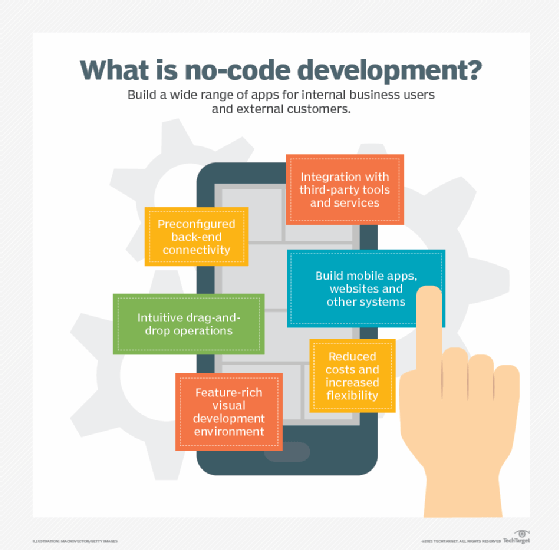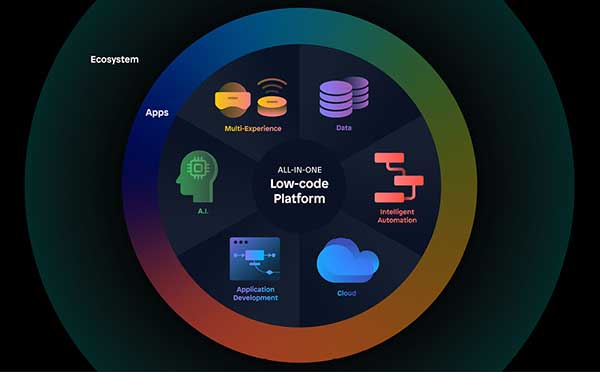Excellent Reasons On Picking Low-Code Platform Info
Excellent Reasons On Picking Low-Code Platform Info
Blog Article
Benefits Of Low-Code Development In Terms Of Speed
Visual Development Environment :
Drag-and-Drop Interfaces: Low-code platforms provide visual tools for designing applications. Developers can use drag-and-drop components to create applications quickly and without writing a large amount of code.
A lot of low-code platforms come with pre-built templates and components. This allows developers to quickly build or prototype applications, without needing to start from scratch.
Reduced Coding Required:
Automated Code Generation Low-code platforms automatically generate the underlying code based on the visual models designed by the developers. This eliminates the requirement for manual code coding and accelerates the development process.
Reusable Parts Developers will be able reuse reusable parts across projects and reduce the amount of time needed to write and testing code.
Collaboration can be streamlined.
Low-code development platforms are often equipped with tools such as deployment, version control, and testing. This enables seamless collaboration between teams.
Citizen Development - Business users, non-developers and other stakeholders can all help in the creation of applications using intuitive user interfaces. This helps to reduce the bottleneck caused by inaccessibility of professional developers.
Rapid prototyping, rapid iteration and rapid prototyping
Rapid Prototyping Developers are able to quickly develop prototypes to allow ideas to be evaluated and feedback to be gathered and analyzed, which leads to faster iterations.
Easy Modifications: The visual nature of low-code development makes it easy to make modifications and updates to applications, which accelerates the process of refining and improving applications based on user feedback.
Pre-built Integrations:
API Integrations. A number of low-code platforms offer connectors that are designed to work with well-known APIs and services. This could speed up the process of integrating systems.
Data Integration: Inbuilt tools for data integration simplify the process of connecting databases and other sources of data, speeding up development.
Deployment & Scaling
One-Click deployment: Many platforms using low-code provide an option to deploy applications, reducing time and effort.
Cloud-based Platforms: Cloud-based platforms which are low-code allow for the management of infrastructure and scaling, meaning developers can focus on the logic and performance of their applications instead of deployment logistics.
The primary benefit of developing applications using low-code, in terms of speed, is its capacity to automate and simplify a variety of aspects in the development process. This allows for faster delivery of applications, and quicker adaptations to changing demands. Take a look at the recommended I thought about this on Low-code Platform for application development for site info including jdbc server, paas service, low code platforms, cross platform app dev, cross platform mobile app development, cross platform mobile development, stored sql procedures, database in azure, low code platforms, software for app development and more.
Advantages Of Low-Code Application Development In Terms Of Flexibility And Scale
Low-code application development has many advantages in terms of scalability and flexibility, which are crucial for building applications that can expand with the needs of businesses and adapt to changing requirements. Here are some of the key benefits.
Cloud-based deployment : Many low-code platforms are cloud built. This allows applications to scale seamlessly along with cloud infrastructure. This allows companies to handle increasing loads without worrying over the management of servers.
Auto-Scaling Features - Built-in automatic scaling capabilities automatically alter resources based on the requirements. This allows for constant performance in peak times without manual intervention.
Flexible Architecture:
Low-code platforms facilitate modular designs where components can independently developed, tested and scaled. Modularity improves flexibility and it's simpler to upgrade specific components of an application without having to affect the entire system.
Microservices Integration Microservices Architecture support lets applications to be constructed as a set of loosely coupled service, increasing both flexibility and scalability.
Custom-designed solutions:
Extensibility. Low-code platforms usually allow for scripting or programming that is custom. This enables developers to expand the functionality of the application beyond what is offered from the box. This allows the fulfilment of unique business needs without limitations.
Third-Party Integrations: The ability to integrate with third-party services and APIs allows companies to add additional functions and services when needed, enhancing the application's capabilities.
Agile Development, Deployment and Agile Development:
Continuous Delivery and Deployment Low-code Platforms can support agile methods through enabling continuous integration and Continuous Delivery (CI/CD). This allows for the rapid release of updates and new features, ensuring that applications can evolve quickly in response to user feedback and market shifts.
Iterative Design: Since low-code is an iterative procedure it is possible to incrementally enhanced and scaled up. This permits controlled growth, and minimizes the risks of large-scale changes.
Resource Optimization
Effective Resource Management Low Code platforms optimize resource usage through tools that monitor and manage the performance of a program. They ensure that resources can be utilized efficiently and increased or decreased depending on actual requirements.
Load Balancing: The integrated load balancing function distributes workloads equally across servers. This increases the application's ability to handle large volumes of traffic and also ensures constant performance.
Global Reach
Multi-Region availability: Lowcode platforms permit to be used across a variety of regions. Businesses can offer users low-latency access to the world. This is crucial, particularly for applications that serve global users.
Localization Support : Built-in localization support allows applications to easily be modified to accommodate different languages and regional needs. This increases their flexibility on diverse markets.
Updates and maintenance:
Simplified Maintenance: The aesthetic and modular nature of low-code applications simplify maintenance tasks making it possible for updates and bug fixes to be completed quickly and without lengthy downtime.
Version Control System for Version Control: These integrated versions manage changes and rollbacks to ensure that updates are able to be deployed and that previous versions can restored if necessary.
Cost Efficiency:
Low development costs. Through reducing the code requirements, low-code platform platforms lower the development cost and permit applications to be scaled up without increasing development efforts.
Pay-As-You-Go Models: Many low-code services offer a variety of pricing models, such as pay-as-you-go, which align costs to actual usage and growth, providing financial flexibility.
Low-code development provides businesses with numerous advantages, including scalability, flexibility and adaptability. This enables them to develop robust, flexible, and scalable apps. These platforms can respond quickly to evolving demands, efficiency of resources, and constant improvements, which allows for the development of applications to evolve as a company. Read the most popular Enterprise application development with Low-code Platform for website recommendations including cross platform mobile development, rapid applications, lowcode no code, stored sql procedures, multiplatform mobile app development, push notifications, build with docker, developing mobile apps, application modernisation, mobile app development platforms and more.
Low-Code App Development Offers Many Advantages In The Area Of Collaboration And Workflow
Low-code applications offer a number of advantages when it comes to collaboration and workflow, making it the ideal option for companies looking to enhance team productivity and speed up development processes. Here are the key benefits: Improved Cross-Functional Collaboration:
Unified Development Environment Low-code platform provides a single unified environment, where all team members including analysts, developers as well as designers, stakeholders, and more, can efficiently work together. This reduces silos and promotes greater communication.
Visual Development Tools: The visually, drag-and-drop nature of low-code platforms makes it easier for team members who are not technical to take part in the process of development, while ensuring that business requirements are accurately captured and implemented.
Communication Enhanced:
Real-Time Collaborative Features: Many platforms using low-code have real-time collaborative features, including comments, editing, and instant feedback. These features facilitate communication and reduce time spent on back and forth discussions.
Shared Workspaces: Teams can work together in shared workspaces, where they can view, edit and discuss aspects of projects, ensuring that everyone's on the same page, and working towards common goals.
A streamlined workflow management system:
Built-in Project Management Tools: Low-code platforms typically include integrated tools for managing projects that aid teams in planning to track and manage their development projects. This includes task assignments as well as progress tracking and deadline management.
Workflow automation: Automating repetitive workflows and tasks can reduce the chance of errors and manual work that allows individuals and teams to focus on more strategic initiatives and improve efficiency.
Speedier Iteration Cycles
Rapid Prototyping Low-code platforms are ideal for quick prototyping. Iterative development is also feasible, allowing the team to develop, test and refine their software in shorter times. This means that feedback can be quickly incorporated and improvements can be made quickly.
Agile Development Support Supporting agile methods lets teams and individuals work in small steps. This can also allow you to quickly adjust to changing circumstances.
Accessibility for non-developers
Citizen Development: Low-code platforms enable business users (citizen developers) to design and develop applications without extensive coding knowledge. This alleviates the burden of IT and development teams, and facilitates faster response to business requirements.
Training and onboarding. The intuitive tools and the extensive training materials help the new team member get up-to-speed and increase the overall level of collaboration.
Centralized documentation and knowledge sharing
Integrated documentation Low-code features typically permit you to create and manage documents on the platform. All project information will be centralized and easily accessible.
Knowledge Repositories : Teams can create knowledge repositories, which include templates, best practices and reusable components. This helps in sharing knowledge and minimizes the need for duplicate efforts.
Consistency in Standardization
Standardized Components: The use pre-built, standard components guarantees the sameness across applications, making it simpler for teams to understand and work on different parts of a project.
Governance and compliance: Integrated governance frameworks help ensure that development adheres to the requirements of regulatory standards and organizational standards. This lowers the risk of non-compliance and also helps applications comply with quality standards.
Feedback Loops and Improvement Loops
Integrated Feedback Mechanisms - Low-code platforms are often equipped with built-in feedback mechanisms. These enable users to give instant feedback about applications that can then be integrated into the development process.
Continuous Improvement: The capability of rapidly implementing changes based upon feedback ensures that applications are continuously improved, aligning closely with the needs and objectives of users.
Visualization, Reporting and Analysis
Real-time Analytics: Built-in analytics and reporting provide real time insights into project performance, user interactions and development. Decision-making based on data is possible.
Visual Workflow Analysis Visual tools are used to map processes and workflows. These tools assist teams determine and improve their workflows.
Low-code development of applications is a powerful tool for collaboration and workflow. It connects different teams, simplifies communication and streamlines processes. This results in more effective and agile development environment that is collaborative.